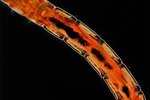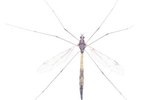
Botflies, or Dermatobia hominis for humans and the genus Gasterophilus for other mammals, are a bumble bee-like fly that require a human or mammal host in order to complete their life cycle. The life cycle of the botfly is comprised of four stages.
Egg Transmission
Adult female botflies lay their eggs on blood-sucking insects, such as mosquitoes or ticks, that they capture during flight. This practice is known as phoresy. After a period of 10 to 140 days, the host insect consumes a blood meal. This transfers the mature botfly eggs from the flying insect to the warm-blooded animal, which then hatch upon feeling the temperature increase. Adult females can also attach their eggs directly onto the hairs of mammal hosts. Egg hatching and larvae movement may cause the mammal to bite or scratch at the area.
It's a Grub Life
The mammal may consume some of the first instar larvae by licking them. Alternatively, the larvae may travel down hair follicles or through bite wounds and burrow into the mammal's skin. From here, the larvae undergo their final two instars, or molt periods, in the skin of the mammal or in the digestive tract during the winter. Larvae developing in the digestive tract attach to the system's walls and feed on tissue. In early spring, they detach as third instars and are expelled through the mammal's feces. Third instar larvae growing in the skin drop from the mammal host after a period of 30 days.
Rest and Renewal
Mature larvae expelled through feces or dropped down from skin in early spring burrow into soil and begin to pupate within two or three days. Pupae do not feed. Instead, they use this time to transform into adults. For a period of one month, the pupae develop adult features, such as wings and antennae. Once fully transformed, sexually mature adult botflies emerge and begin the life cycle over again.
Life Cycle Completion
Like pupae, adult botflies do not feed. Newly emerged from their pupal cases, the adult botflies have sensitive antennae to make up for their poor vision. Male and female adults depend on their sensitive antennae to find each other and mate. During summer and fall, adult females seek hosts for their eggs, whether they catch a fly or mosquito and transfer their eggs to them, or directly attach their eggs to warm-blooded mammals such as cattle, rabbits, sheep and horses.
References
- University of Florida: Dermatobia Hominis
- Centers for Disease Control & Prevention: Dermatobia Hominis
- NC State University: Horse Bot Flies
- Texas A&M University: Horse Bot Fly
- U.S. Department of Agriculture: Dermatobia Hominis Life Cycle
- University of Florida: Gasterophilus Intestinalis
- University of Michigan: Dermatobia Hominis
Photo Credits
-
Karl Weatherly/Photodisc/Getty Images
Writer Bio
Amanda Williams has been writing since 2009 on various writing websites and blogging since 2003. She enjoys writing about health, medicine, education and home and garden topics. Williams earned a Bachelor of Science in biology at East Stroudsburg University in May 2013. Williams is also a certified emergency medical technician.




